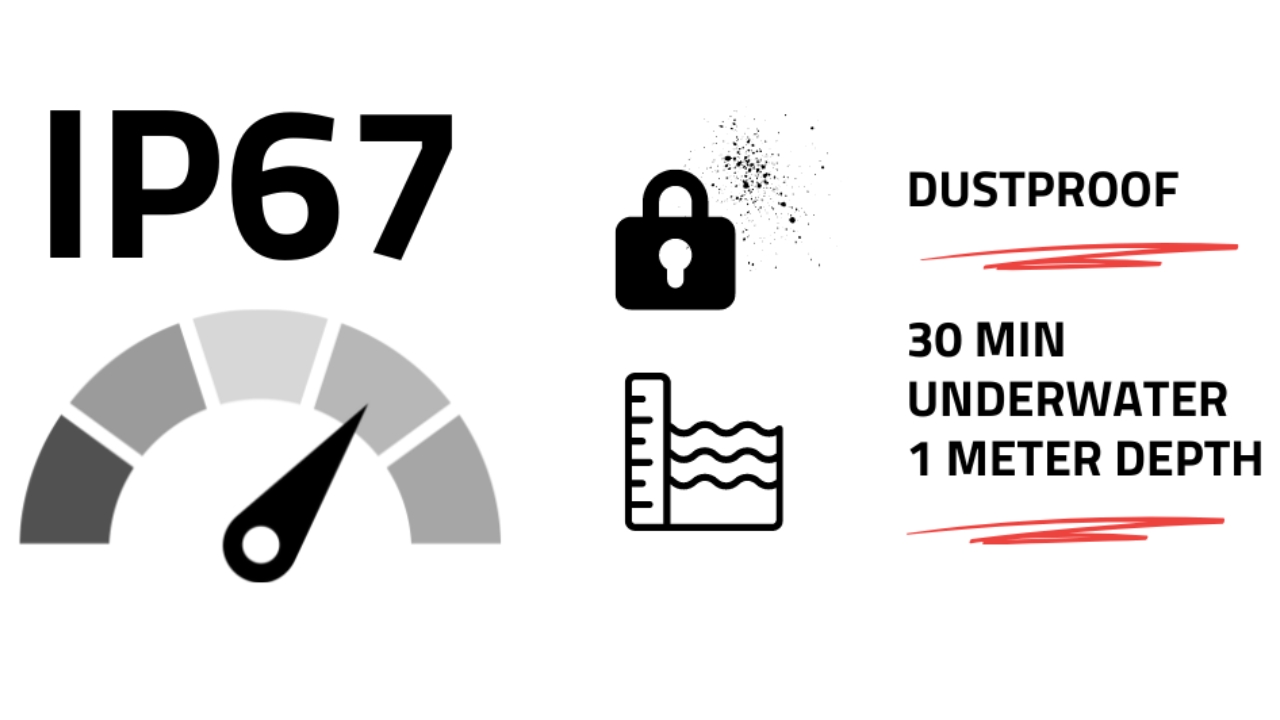When selecting your electrical enclosure or setting your outdoor lighting it is important that you understand what IP ratings are. Two important ratings that you’ll most likely come across are IP65 and IP67. However, what do they mean and which of them suits your needs? Let’s find out!
What is IP65?

IP65 is a standard rating that indicates the level of protection of a specific device against liquids and solids. The first digit “6” indicates full dust protection, while the second digit “5” indicates protection against water jets of low pressure from all directions.
What is IP67?

IP67 is a protection rating that indicates the resistance level of a device to water and dust. The first digit “6” indicates full protection from dust, while the second digit “7” means protection from water immersion up to a meter deep for about 30 minutes. This helps in ensuring durability for underwater, industrial, and outdoor uses.
IP65 vs IP67: What are the Main Differences?

Before you choose an IP-rated device for any application, it is important you understand the level of water and dust protection it offers. While IP65 and IP67 are popular ratings that both offer protection, they have their significant differences. These differences are evident in their performance. In this article, we will be explaining the differences in these ratings and their suitable applications.
Dust Protection
As regards the level of dust protection, these IP65 and IP67 both offer the best protection against particles like debris and dust. The “6” in the two IP ratings signifies full protection against dust accumulation. If you choose devices that are IP65 or IP67-rated, no amount of particles or dust can get through such devices.
You can use devices with such ratings in applications where there is frequent exposure to dust and particles. IP65 and IP67 devices are both ideal for outdoor settings and construction worksites.
Water Resistance
The “5” in IP65 ratings signifies the level of water protection. Devices with this rating offer protection against water jets. Also, you can use devices in applications where there is exposure to water splashes or rain. It is important you know that you can’t use these devices for full water submersion.
The level of water resistance offered by IP67-rated devices is much higher. The second digit after IP i.e. “7” signifies the ability to withstand submersion in water with 1 meter depth. You can immerse such devices in water for about 30 minutes. Therefore, you can use IP67 rating for applications involving temporary immersion.
While IP65 offers resistance against water jets, IP67 can withstand short time immersion in water. If you will be using the device for high exposure to moisture, you should consider IP67 as a better choice.
Durability
Although IP65- rated products can tolerate outdoor settings with exposure to rain and minimal environmental challenges, they can’t withstand immersion or harsh usage. You can use IP65 devices for display panels, surveillance cameras, and outdoor lighting systems.
IP67 devices, on the other hand, are more durable and can survive extreme weather conditions. These devices aren’t only dust proof, but can withstand immersion. Therefore, you can integrate devices with IP67 ratings in outdoor settings and marine applications with a high level of exposure to water.
Environmental Use
As much as both ratings provide a good level of dust protection, they differ in their tolerance level in certain environments.
For instance, IP65-rated devices can perform well in outdoor settings where low exposure rain or splashes are frequent. While they are useful for display panels and outdoor lighting, they can’t withstand harsh environmental conditions.
Meanwhile, you can use IP67-rated devices for applications where there is temporary water submersion. These devices aren’t only dust proof, but they are also useful withstanding impact or vibration.
Therefore, devices with this rating are highly preferred for use in marine environments and industrial settings that require frequent water submersion or washing.
The differences in their tolerance level in certain environments reveals a much bigger picture. For applications where there is moderate or occasional water exposure, you can use IP65-rated products. IP67 devices are more suitable for harsher conditions and environments with high exposure to water.
Cost
There is a significant difference between. IP65 and IP67-rated devices in terms of cost. Devices with IP67 ratings are usually more expensive than that of IP65 ratings due to the level of protection they offer. Devices that offer higher levels of protection against water and dust have more manufacturing complexity, hence, the reason behind their high cost.
IP67 devices are a costly option due to their enhanced waterproofing and dust proofing features. It is advisable you go for IP65 products if you will be using them for indoor or semi-outdoor settings.
You don’t need IP67 devices for applications that don’t require water immersion. However, it is important you don’t compromise cost for durability. Therefore, ensure you consider the requirements of the application environment before you make your final decision.
Application Use
There are different applications that call for the need of IP65- rated or IP67-rated devices.
Common applications for IP65
- Outdoor lighting fixtures
- Electronic display panels
- Security cameras
Common applications for IP67
- Smartphones or wearables designed for water submersion
- Industrial equipment exposed to frequent washing
- Marine electronics
It is important you study the frequency of water exposure in your application before you choose which rating is suitable. IP67 still remains a better option for heavy water exposure while IP65 is more suitable for occasional splashes.
Maintenance
The frequency of maintenance and repair in IP65- rated devices and IP67-rated devices differs. For IP65 devices, you need occasional inspection to prevent water from accumulating on seals. This is much different in IP67 devices as they don’t require inspection.
These devices are designed to withstand harsh conditions, hence they offer a more enhanced seal that prevents water or dust from getting through.
Installation
The installation of these devices determine their performances. You can jeopardize your IP65 or IP67 devices if you fail to install them properly. Improper installation can cause water or dust to penetrate your device.
Installation Tips
- Make sure you secure the seals properly.
- Read manufacturer guidelines to know the exposure limits.
- Use appropriate accessories for the IP rating.
Weight Difference
IP67-rated devices are made of heavier materials and also have extra protective layers which contribute to their heavy weight. On the other hand, IP65 are lightweight and as such, have a sleeker and more beautiful design.
Although IP67 devices offer enhanced protection, they aren’t as sleek as IP65 devices. Therefore, if you are considering IP-rated devices that offer protection and sleek design, you should opt for IP65.
IP65 vs IP67: Which Rating is More Suitable?

While IP65 will thrive in certain conditions, they may not be suitable in some environments. Therefore, your application environment will determine whether to choose IP65 or IP67 ratings. Although both ratings offer water and dust protection, they differ in terms of their water resistance level.
Outdoor Electronics
For electronics placed in outdoor areas, it is advisable to choose IP67 ratings. Such devices include smart home devices, cameras, and sensors. You can install these devices where there are harsh and unpredictable weather conditions.
There are possibilities of accidental submersion and rain in such settings, therefore it is more suitable to choose IP67 ratings because they offer full protection against water and can survive immersion in water that is 1 meter deep.
Outdoor Lighting System
Lighting fixtures placed in outdoor areas need a high level of water protection. For instance, garden lights, patio lights, and streetlights have rare exposure to water immersion. Therefore, you should choose IP65 ratings for such applications.
Apart from providing protection against dust, this rating ensures protection against water jets. IP65-rated lighting systems are a more cost-effective option since they offer enhanced durability.
Wearables
IP67 ratings are suitable for wearables like fitness trackers and smart watches. In most cases, you expose these devices to accidental splashes, rain, and even sweat. These are personal electronics that are likely to have more frequent exposure to moisture. Therefore, it is important you prioritize durability. Also, smartphones have IP67 ratings since the probability of exposing them to moisture is high.
Industrial Settings
Industrial environments are very different. Therefore making your choice between IP65 vs IP67 involves some exposure risks.
- For environments having dust as well as splashes on some occasions, it is nice to use an IP65-rated device.
- For settings whereby you may subject the equipment to heavy rain, high-pressure cleaning, or temporary submersion, then it’s advisable you choose IP67.
Assessing the water exposure level as well as its surrounding features will help in determining the most suitable rating to suit your industrial applications.
Conclusion

Comparing IP65 vs IP67, they both provide reliable protection from dust, however, they have different water resistance levels. With an IP65 rating, you can withstand water jets, and with IP67, you can withstand temporary water immersion.
Select IP65 when seeking affordable solutions in environments that are prone to rainfall and choose IP67 when your device requires more durability, could face harsh conditions, and possible submersion. This is why you should choose a reliable electrical exposure manufacturer that uses the right IP ratings to reduce risks and provide better protection.
FAQs
Can I use IP65 devices in underwater settings?
No, you can’t use IP65 devices underwater. Although these devices have enhanced seals which protect against water and dust, they can’t survive water immersion.
Is IP67 rating immoderate for outdoor lighting?
For outdoor lighting, IP67 rating can be immoderate. IP65 is suitable for lighting systems as they offer the appropriate protection against dust and rain. However, if there will be exposure to immersion or flooding, IP67 can be a suitable option.
Do IP ratings determine the cost of a device?
Devices with higher IP ratings tend to be more expensive than those with low IP rating. This is because higher IP-rated devices are made of high-quality materials, have enhanced sealing, and better durability.



